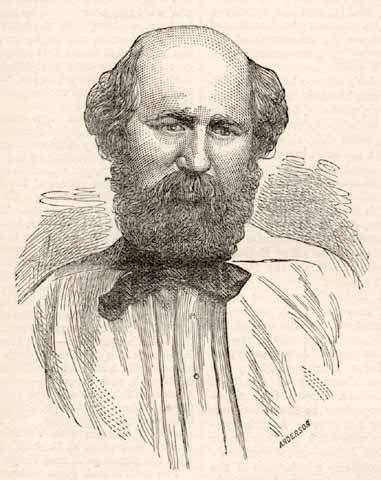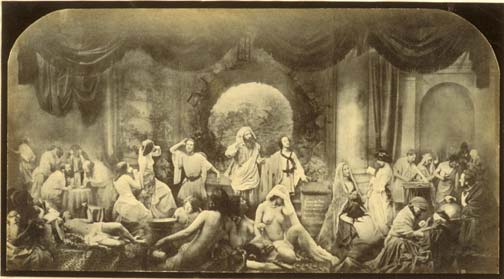PSS Exhibitors
Oscar Gustav Rejlander |
|
OG Rejlander © Reproduced by courtesy of Edinburgh Photographic Society This engraving of Rejlander is from a photograph taken in his own studio. [OG Rejlander obituary: British Journal of Photography, 1875, p.54] |
|
Sweden - Rome - Wolverhampton - London OG Rejlander was born in Sweden, son of a Swedish Army Officer, and studied in Rome. In England, he was first a portrait painter, then a photographer, working in Wolverhampton. He moved to London, possibly in 1860. He had a studio at Haymarket, then Kentish Town, then Victoria Street, Westminster. He died at his home in Clapham, London, on 18 January 1875, aged 61. He had been a pioneer photographer, his photographs often being engraved for religious publications. He had an appreciation of the Old Masters, copying many of their works. [OG Rejlander obituary: British Journal of Photography, 1875, p.54] |
|
Two Ways of Life E Draper wrote, in the British Journal of Photography [BJP:1875, p.54] "Without encouragement, with the most imperfect appliances, with nothing but coarse work girls and non-professional male models, and under other difficulties of the most disheartening nature - with no possibilities demonstrated for his guidance, no examples of success to encourage him - he took up the camera, as he took up the brush and pencil to embody therewith the creations of a previously-educated mind. He resolved to do what never had been done, and what crowds of able thinkers in art declared loudly, never could be done, and he produced as a first result 'The Two Ways of Life', which was exhibited in the Art Treasures' Exhibition in Manchester." [OG Rejlander obituary: British Journal of Photography, 1875, p.54] It was the Rejlander's 'Two Ways of Life' that caused controversy amongst the Members of The Photographic Society of Scotland, when he submitted it to their Exhibition in December 1857. |
|
Two Ways of Life - O G Rejlander © The Royal Photographic Society, Bath, England. web site http://www.rps.org.
This photograph was made using thirty different negatives. The Photographic Society of Scotland rejected this photograph when it was submitted to their Exhibition. Edinburgh’s professional photographers were unhappy with this decision. A Special General Meeting of the PSS was called, but did not result in the changes demanded by many of Edinburgh's professional photographers. Many of Edinburgh's professional photographers subsequently left the Photographic Society of Scotland. They went on to join Edinburgh Photographic Society when it was established in 1861. |
|
Tributes to O G Rejlander |
|
The death of Rejlander was reported to a Meeting of Edinburgh Photographic Society on 3 February 1875. At the same Meeting, an album, lent by Mr Constable, containing a large collection of pictures by the late OG Rejlander was laid on the table, together with a collection of mounted prints by Rejlander, lent by Mr Elliott. Several Members paid tribute to OG Rejlander. Below are some extracts: [BJP: 12 Feb 1875; p. 81] |
|
Tribute to OG Rejlander "I feel confident that all present will agree with me when I say that the lamented death of O Rejlander has left a vacant space in the ranks of photography which few, if any, are able to fill; indeed I have never met any who did not willingly bear testimony to the artistic excellence of his pictures. We can all tell a "Rejlander" at a glance - not from any particular mode of lighting or style of background, but from the impress on the artist's own genius, which is more or less stamped upon them all. My own admiration of his works has all along been so sincere and so ardent that, somehow, I have remained entirely blind to his alleged defects as a manipulator. ... There is one [letter] likewise from Mrs Rejlander containing an account of her husband's funeral, the expenses of which, I fear, will leave but a small balance at her banker's. A few friends, however in Edinburgh are endeavouring to dispose of Prince Albert's picture by subscripton, for the purpose of helping the widow in her affliction, which is really the true and proper way to honour the memory of our departed friend and brother OG Rejlander" [BJP: 12 Feb 1875; p. 81] |
|
Tribute to OG Rejlander "The photographer with a true knowledge of the art will conceive the picture in his brain, train and manipulate his model to be what he has conceived, and then make his camera reproduce the conception. This was the way Rejlander set about his work, and the result - those magnificent pictures on the table - was beyond all praise. [BJP: 12 Feb 1875; p. 81] |
|
Tribute to OG Rejlander "The photographer with a true knowledge of the art will conceive the picture in his brain, train and manipulate his model to be what he has conceived, and then make his camera reproduce the conception. This was the way Rejlander set about his work, and the result - those magnificent pictures on the table - was beyond all praise. [BJP: 12 Feb 1875; p. 82] |
|
Rejlander Memorial Fund In June 1875, a notice appeared in the BJP announcing the creation of the 'Rejlander Memorial Fund', to meet some claims that existed at the death of Rejlander, and to make some provision for his widow. [BJP: 4 Jun 1855] |
|
O G Rejlander in Edinburgh |
|
Here is an article about O G Rejlander's visit to Edinburgh in 1866, when he was entertained by Edinburgh photographers. This article was published in British Journal of Photography in 1866. (I've added the two thumbnail images below. They did not appear in the BJP article.) |
|
A London Photographer in Scotland "It affords us great pleasure to learn, from an eminent Edinburgh photographer, that Mr Rejlander, who is at present on a visit to the "Modern Athens" has met with a most cordial reception from the leading members of the Royal Scottish Academy, at the residences of some of whom he has been entertained as an honoured guest. Nor are the principal photographers behind the academicians in this respect, as he was by them entertained to dinner at the Café Royal on Monday last, on which occasion Mr Wood occupied the chair. Among those present were Messrs Clark, Rodd, Dallas, Tunny, Hay, Henderson, Moffat, McCraw, &c., &c. After a sumptuous entertainment, followed by the usual loyal toasts, the chairman proposed the health of the guest of the evening. Mr Rejlander, he said was a gentleman whose great artistic abilities and skill were so well known to them as to render it unnecessary for him to comment upon those qualities. He referred especially to his composition pictures, of which he had all along had the highest possible opinion - an opinion shared in by all artists capable of judging, notwithstanding the fact that attempts had been made in certain quarters to depreciate them. Mr Rejlander, he said was a gentleman who not only had an imagination to conceive and a judgement to direct, but had a hand to execute the conception of his brain in the most beautiful, pleasing and artistic manner. His great picture 'The Two Ways of Life' was in every respect worthy of his genius both as an artist and as a photographer notwithstanding the averments made against it by "Tooley Street tailors", quasi-artists, and others of that class. The toast was drunk in a most enthusiastic manner, and Mr Rejlander responded in suitable terms. Mr Ross (photographer to the Queen), who officiated as vice-chairman, craved the liberty of being allowed to state, in confirmation of the chairman's remarks, that he knew of no other photographer, at home or abroad, who had done so much for photography in an artistic point of view as Mr Rejlander. Photography, he continued, might be in the hands of many of those who practised it, a very mechanical or common art; but he certainly did think that a man who produced such photographs as "Day and Night in London" might look any artist in the face who painted the same class of subjects with the brush, and, without any presumption, bid him "Hail fellow, well met! Photographers know that they never could soar to the regions of high art - that it was the painter only who could idealise his subject, and although Mr Rejlander could not "raise a mortal to the skies, or draw an angel down", yet he had produced many pictures well suited to "point a moral or adorn a tale"; and in his great picture of "The Two Ways of Life", he had held the camera up to nature, shown virtue her own features, and vice her own image, in a manner and mode that deserved all the honour and all the praise that had been accorded to him. Mr Tunny followed with some appropriate remarks; and many other toasts were proposed and responded to, mixed up here and there with recitations and Scottish songs, and the brethren of the camera spent a very happy evening." British Journal of Photography on February 16, 1866 Acknowledgement: Thank you to Ron Cosens for telling me about this BJP article. |



